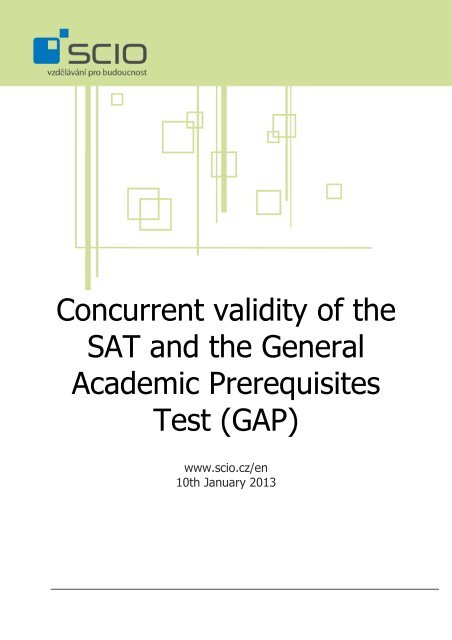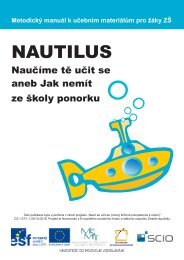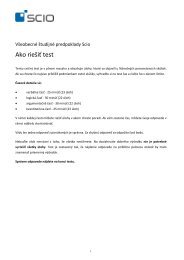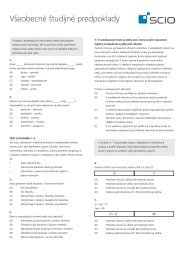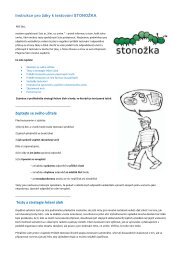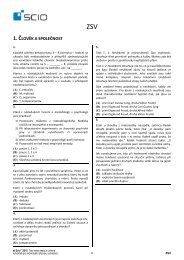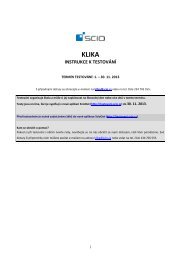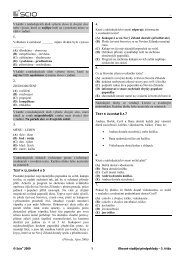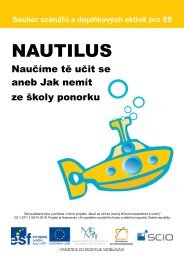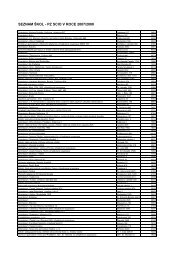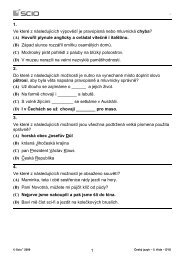Concurrent validity of the GAP and the SAT - Scio
Concurrent validity of the GAP and the SAT - Scio
Concurrent validity of the GAP and the SAT - Scio
You also want an ePaper? Increase the reach of your titles
YUMPU automatically turns print PDFs into web optimized ePapers that Google loves.
<strong>Concurrent</strong> <strong>validity</strong> <strong>of</strong> <strong>the</strong> <strong>SAT</strong> <strong>and</strong> <strong>the</strong> General AcademicPrerequisites Test (<strong>GAP</strong>)AbstractThere are many tests for general skills assessment. Some <strong>of</strong> <strong>the</strong>m are well-known <strong>and</strong> widelyaccepted for admission purpose, like <strong>SAT</strong> or GRE. But in non-English speaking countries, <strong>the</strong>irusage is doubtful due to country-specific <strong>and</strong> language-specific issues. <strong>Scio</strong>, <strong>the</strong> Czechassessment company, has been developing its study aptitude test called “test Obecnýchstudijních předpokladů (OSP)” (General Academic Prerequisites test, abbr. <strong>GAP</strong>) since 1996.Many universities in <strong>the</strong> Czech Republic <strong>and</strong> <strong>the</strong> Slovak Republic have been using that test (aspart <strong>of</strong> <strong>the</strong> National Comparative Exams, abbr. NCE) in admission process. The concurrent<strong>validity</strong> <strong>of</strong> <strong>GAP</strong> <strong>and</strong> <strong>SAT</strong> tests has been analysed <strong>and</strong> <strong>the</strong> outcomes prove high correlationbetween <strong>GAP</strong> <strong>and</strong> <strong>SAT</strong> results, ei<strong>the</strong>r in overall score <strong>and</strong> in Critical Reading <strong>and</strong> Mathsections. <strong>SAT</strong> Exam<strong>SAT</strong>s are used by many universities in <strong>the</strong> USA <strong>and</strong> o<strong>the</strong>r countries around<strong>the</strong> world as one <strong>of</strong> <strong>the</strong> admission criteria. More information on: www.collegeboard.org.General Academic Prerequisites Test (<strong>GAP</strong>)Verbal sectionMeasures <strong>the</strong> ability to comprehend long, complex texts <strong>and</strong> <strong>the</strong>ir interpretation, distinguishdifferences between <strong>the</strong> meaninsg <strong>of</strong> words, coming to correct conclusions after reading a text.Analytical sectionEvaluation <strong>of</strong> logical reasoning, analysing <strong>and</strong> working with dataQuantitative sectionTests elementary ma<strong>the</strong>matical skills, working with numbers <strong>and</strong> values, ability to read <strong>and</strong>interpret spreadsheets <strong>and</strong> charts <strong>and</strong> performing elementary ma<strong>the</strong>matical operations without<strong>the</strong> use <strong>of</strong> a calculator.<strong>GAP</strong> sample: http://www.scio.cz/1_download/gapsample.pdf<strong>GAP</strong>Testing time (minutes) 90Number <strong>of</strong> queries 85Number <strong>of</strong> sections verbal (35)analytic (25)quantitative (25)Taking points <strong>of</strong>f for incorrect answersYESGross success rate between 50 - 60%Average discrimination between 31 - 38%ReliabilityCronbach alfa between 0,89 - 0,92KR-20 between 0,89 - 0,93Data <strong>and</strong> MethodFrom December 2009 to June 2012 we asked participants <strong>of</strong> <strong>the</strong> <strong>GAP</strong> test in <strong>the</strong> NCE, whe<strong>the</strong>r<strong>the</strong>y have recently passed <strong>the</strong> <strong>SAT</strong>. The o<strong>the</strong>r group were participants <strong>of</strong> <strong>the</strong> <strong>SAT</strong>, but not <strong>the</strong><strong>GAP</strong>, who were <strong>of</strong>fered passing <strong>the</strong> <strong>GAP</strong> test free <strong>of</strong> charge. That way we have got <strong>the</strong> sample<strong>of</strong> 108 persons with certified results both in <strong>the</strong> <strong>GAP</strong> <strong>and</strong> in <strong>the</strong> <strong>SAT</strong>, a few <strong>of</strong> whom have
passed <strong>the</strong> <strong>SAT</strong> test more than once. The most recent date <strong>of</strong> passing <strong>the</strong>ir <strong>SAT</strong> was 2008 orlater for 104 <strong>of</strong> 108 persons, three passed it in 2007 <strong>and</strong> one in 2005. However, <strong>the</strong> majority <strong>of</strong>persons in our sample have passed <strong>the</strong>ir <strong>SAT</strong> <strong>and</strong> <strong>GAP</strong> test within <strong>the</strong> span <strong>of</strong> one year.The <strong>SAT</strong> gives results as scores for three separate sections: Critical Reading, Math <strong>and</strong>Writing. There is no overall score. The <strong>GAP</strong> has three sections, too (see <strong>the</strong> <strong>GAP</strong> testspecification above), but <strong>the</strong> outcomes are given as percentiles in each <strong>of</strong> <strong>the</strong> sections as well asan overall percentile.Normally, one may take part in <strong>the</strong> NCE more than once during <strong>the</strong> season (from December toJune). If so, his or her final result is <strong>the</strong> best <strong>of</strong> all attempts. Many <strong>of</strong> participants utilise thatbenefit every year <strong>and</strong> so did many <strong>of</strong> <strong>the</strong> members <strong>of</strong> our sample. On <strong>the</strong> o<strong>the</strong>r h<strong>and</strong>, <strong>the</strong>majority <strong>of</strong> subjects in our sample had taken part in <strong>the</strong> <strong>SAT</strong> only once. Therefore, for <strong>the</strong> sake<strong>of</strong> properly comparing <strong>the</strong>ir <strong>GAP</strong> score with <strong>the</strong>ir <strong>SAT</strong> score, we have taken only <strong>the</strong> firstattempt results <strong>of</strong> <strong>the</strong> <strong>GAP</strong> test into account.To have a good concurrent <strong>validity</strong>, <strong>the</strong> <strong>GAP</strong> test should keep examinees in very similar rank as<strong>the</strong> <strong>SAT</strong> test. We <strong>the</strong>refore computed Spearman correlation coefficients between <strong>the</strong> <strong>SAT</strong> <strong>and</strong><strong>the</strong> <strong>GAP</strong> outcomes.If <strong>the</strong> <strong>GAP</strong> <strong>and</strong> <strong>SAT</strong> even were congeneric tests (within <strong>the</strong> meaning <strong>of</strong> <strong>the</strong> classical test<strong>the</strong>ory) <strong>and</strong> so had a perfect concurrent <strong>validity</strong>, <strong>the</strong> Pearson correlation between observedscores would be still lower than 1 – <strong>the</strong> upper limit is a square root <strong>of</strong> <strong>the</strong> product <strong>of</strong>reliabilities. To compare <strong>the</strong> real reliability with this optimal case, Pearson correlationcoefficients between <strong>the</strong> <strong>SAT</strong> <strong>and</strong> <strong>GAP</strong> outcomes were computed, too. For this purpose, <strong>the</strong><strong>GAP</strong> outcomes have been transformed from percentiles by normal quantile function to becloser to <strong>the</strong> normal distribution assumption.Correlation AnalysisTable 1 presents <strong>the</strong> Spearman correlation coefficients between sections <strong>and</strong> overall outcomes<strong>of</strong> both tests. Table 2 does <strong>the</strong> same for Pearson correlation coefficients, when <strong>GAP</strong> outcomesare transformed towards <strong>the</strong> normal distribution.Table 1. Spearman correlation coefficients between <strong>SAT</strong> scores <strong>and</strong> <strong>GAP</strong> percentiles<strong>GAP</strong>percentiles<strong>SAT</strong> scoresCriticalReading Math Writing MeanVerbal 0.697 0.572 0.552 0.687Analytical 0.584 0.600 0.463 0.630Quantitative 0.410 0.707 0.362 0.533Overall 0.681 0.729 0.536 0.739Correlations <strong>of</strong> overall outcomes are very high <strong>and</strong> <strong>the</strong>y witness about a strong relationshipbetween <strong>the</strong> <strong>SAT</strong> <strong>and</strong> <strong>GAP</strong> results. Among test sections, strong relationships are observed bothbetween <strong>the</strong> <strong>SAT</strong> Critical Reading <strong>and</strong> <strong>GAP</strong> Verbal sections <strong>and</strong> between <strong>the</strong> <strong>SAT</strong> Math <strong>and</strong><strong>GAP</strong> Quantitative sections. Only <strong>the</strong> <strong>SAT</strong> Writing section has no strong partner in <strong>the</strong> <strong>GAP</strong>test, while <strong>the</strong> <strong>GAP</strong> Analytical section has probably some relation to <strong>the</strong> <strong>SAT</strong> Math section.
Table 2. Pearson correlation coefficients between <strong>SAT</strong> scores <strong>and</strong> <strong>GAP</strong> transformed(normalized) percentiles<strong>SAT</strong> scores<strong>GAP</strong>transf.percentilesCriticalReading Math Writing MeanVerbal 0.711 0.583 0.603 0.713Analytical 0.593 0.634 0.498 0.643Quantitative 0.451 0.729 0.388 0.576Overall 0.702 0.755 0.585 0.761The numbers in Table 2 are similar to those in Table 1, <strong>the</strong>y are even slightly higher. The 95%confidence intervals for highlighted coefficients, under assumption <strong>of</strong> normal distribution <strong>of</strong>both <strong>SAT</strong> <strong>and</strong> <strong>GAP</strong> scores, lie approximately between 0.62 <strong>and</strong> 0.84, so our sample seems to besufficient for proving <strong>the</strong> strength <strong>of</strong> relationship.As we stated in Data And Method chapter, even in <strong>the</strong> optimal case <strong>of</strong> perfect concurrency wewould get correlations lower than 1. The upper limit for correlation in optimal case, i. e. at leastcongeneric tests, is a square root <strong>of</strong> <strong>the</strong> product <strong>of</strong> reliabilities. Table 3 presents mean section<strong>and</strong> overall reliabilities for <strong>the</strong> <strong>SAT</strong> <strong>and</strong> <strong>GAP</strong>. The upper limit for possible correlation betweentests is computed in <strong>the</strong> bottom row.Table 3. Section <strong>and</strong> overall reliabilities for <strong>the</strong> <strong>SAT</strong> <strong>and</strong> <strong>GAP</strong>sections overall<strong>SAT</strong> 0,91 0,94<strong>GAP</strong> 0,83 0,91correlation limit 0,87 0,92As we see, reaching correlation 0.761 is very good when more than 0.92 is impossible. Thesame may be said about correlations between outcomes in particular sections – reaching 0.711<strong>and</strong> 0.729 is great when having 0.87 as <strong>the</strong> upper limit.DiscussionThe real correlations between <strong>the</strong> outcomes <strong>of</strong> <strong>SAT</strong> <strong>and</strong> <strong>GAP</strong> tests may be even higher thancomputed. There were at least three factors bringing some amount <strong>of</strong> noise into <strong>the</strong> relation <strong>of</strong>he test results for every participant in our sample:1. The <strong>SAT</strong> is in English, but <strong>the</strong> language <strong>of</strong> <strong>the</strong> <strong>GAP</strong> test, as well as <strong>of</strong> <strong>the</strong> most <strong>of</strong> itsparticipants, is Czech or Slovak. So outcomes <strong>of</strong> <strong>the</strong> <strong>SAT</strong> reflect also English languageskills while <strong>the</strong> <strong>GAP</strong> outcomes do not.2. The <strong>SAT</strong> <strong>and</strong> <strong>the</strong> <strong>GAP</strong> were not passed in <strong>the</strong> same time, <strong>the</strong>re may be a gap <strong>of</strong> somemonths or years. So outcomes do not reflect <strong>the</strong> same exact situation <strong>of</strong> examinees.3. There were no participants <strong>of</strong> <strong>SAT</strong> with poor results in <strong>the</strong> <strong>GAP</strong> test in our sample. If weadded participants with poor results in <strong>the</strong> <strong>GAP</strong> to <strong>the</strong> sample, <strong>the</strong>y would probably reachpoor results in <strong>the</strong> <strong>SAT</strong> too, so <strong>the</strong> correlation coefficients would probably increase.
References <strong>and</strong> links1. <strong>SAT</strong> specification:http://pr<strong>of</strong>essionals.collegeboard.com/testing/sat-reasoning/about/sections2. <strong>GAP</strong> description <strong>and</strong> sample tests:http://www.scio.cz/nsz/cs/osp.asp3. Davidsh<strong>of</strong>er; Murphy, K. R.; Charles, O. Psychological testing: principles <strong>and</strong> applications(6th ed.). Upper Saddle River, N.J.: Pearson/Prentice Hall. ISBN 0-13-189172-3.4. Correlation at Wikipedia:http://en.wikipedia.org/wiki/Correlation_<strong>and</strong>_dependence5. Reliability And Validity at Wikiversity:http://en.wikiversity.org/wiki/Reliability_<strong>and</strong>_<strong>validity</strong>ConclusionCorrelation analysis proves that overall outcomes <strong>of</strong> <strong>the</strong> <strong>SAT</strong> <strong>and</strong> <strong>GAP</strong> tests are highlycorrelated, ei<strong>the</strong>r by means <strong>of</strong> rank correlation (Spearman) or <strong>the</strong> common Pearson correlation.Moreover, it is very likely that <strong>the</strong> real correlation is underestimated. The concurrent <strong>validity</strong> <strong>of</strong><strong>the</strong> overall <strong>GAP</strong> test score is high with respect to <strong>the</strong> well-known <strong>and</strong> certified <strong>SAT</strong>.The verbal section <strong>of</strong> <strong>the</strong> <strong>GAP</strong> test has high concurrent <strong>validity</strong> with respect to <strong>the</strong> <strong>SAT</strong> CriticalReading section. The same holds for <strong>the</strong> quantitative section <strong>of</strong> <strong>the</strong> <strong>GAP</strong> test with respect to <strong>the</strong><strong>SAT</strong> Math section. The only section in <strong>the</strong> <strong>SAT</strong> without direct partner in <strong>the</strong> <strong>GAP</strong> is Writing;<strong>the</strong> Analytic section in <strong>the</strong> <strong>GAP</strong> tends to both Critical Reading <strong>and</strong> Math but <strong>the</strong> relation is notso strong.Should you be interested in fur<strong>the</strong>r information, please contact:Jan Hučínjhucin@scio.czwww.scio.cz/en , s.r.o. | department <strong>of</strong> science <strong>and</strong> research


